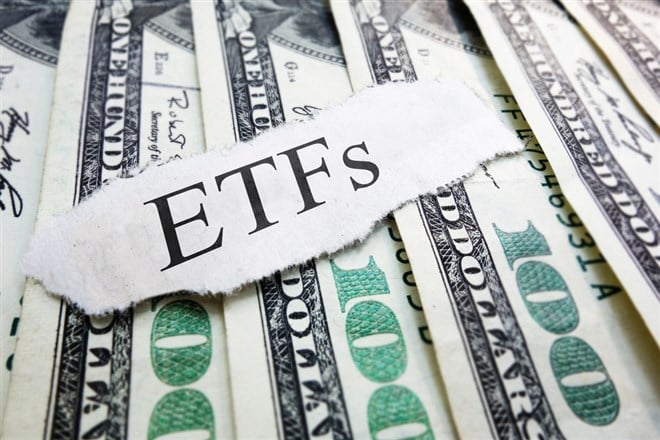Ticker Reports for September 12th
3 Leveraged ETFs to Multiply Returns
Exchange-traded funds (ETFs) are typically considered to be suitable investments for retail investors who have a hands-off approach. The built-in portfolio diversity inherent to many of these funds and the ability to hand over management of a fund's basket of securities to a team of professional managers appeal to beginning investors and those not eager to involve themselves in the business of regular trading. This is a major reason behind the meteoric rise of ETFs in recent years.
Nonetheless, some of the most successful funds in this space are designed for experienced investors with the expertise to handle complex—and oftentimes much riskier—investment strategies. ETFs employing leveraged strategies to amplify the returns of a target index are more suitable for investors interested in an active approach.
NVDL: Big Wins on NVIDIA Gains
As one of the largest companies in the world and a leading manufacturer of hardware used in ultra-popular AI applications, NVIDIA Corp. (NASDAQ: NVDA) is justifiably one of the most talked-about stocks today. As evidence of this, NVIDIA's success in recent quarters has prompted the launch of a number of ETFs specifically targeting this company. While such a narrow focus is uncommon in the ETF space, the fact that many of these funds are leveraged—allowing them to aim for returns double or triple the daily performance of NVIDIA shares—makes them a draw for bullish investors.
The GraniteShares 2x Long NVDA Daily ETF (NASDAQ: NVDL) utilizes derivatives to provide a leveraged long play on NVIDIA. The fund aims to generate returns of twice the daily performance of the company in question. One aspect of NVDL that helps it to stand out among its NVIDIA-focused peers is its strong asset base and trading volumes. NVDL has assets under management totaling $3.9 billion and a 1-month average trading volume approaching 28,000,000. These elements ensure that NVDL offers superior liquidity, which is essential when investors must be ready to unload all NVDL each day in order to avoid a constant leverage trap.
FNGU: Powerful Short-Term Tech Access
Investors optimistic about the tech space but looking for somewhat broader exposure than a single stock might turn to the MicroSectors Fang+ Index 3X Leveraged ETN (NYSEARCA: FNGU), which aims for triple the daily returns of five of the so-called FANG tech leaders and a small number of additional growth stocks in the space.
Like other leveraged funds, FNGU is not designed for a buy-and-hold strategy, but rather is best suited to investors that will turn over their holdings daily. Its healthy 1-month average trading volume of over 1 million and AUM of $4.8 billion support liquidity. On the other hand, it has an expense ratio of 0.95%, notably higher than most index ETFs available.
SPXL: Bullish S&P Opportunity
The Direxion Daily S&P 500 Bull 3X Shares ETF (NYSEARCA: SPXL) offers leveraged exposure to the broader market by aiming for triple the daily returns of the S&P 500. Investors optimistic about the short-term performance of large-cap stocks can maximize their potential returns through targeted exposure, though, as with other leveraged funds, holding SPXL for a period of longer than a day may lead to performance that diverges significantly from the market.
SPXL is an attractive option among leveraged funds providing broad market exposure because it offers access to the entirety of the S&P 500, whereas a competitor like the ProShares UltraPro QQQ (NASDAQ: TQQQ) gives exposure to a more limited set of names in the NASDAQ. By aiming for triple daily returns, SPXL can significantly amplify gains on a strong day for the market. However, it can conversely magnify losses as well.
Strong Potential for Those With Risk Tolerance
An essential element to each of these leveraged ETFs is their risk profile, which is greatly enhanced relative to most other ETFs. Investors would be wise to carefully consider their own tolerance before exploring these and other leveraged funds. Volatility decay is also a significant concern for investors holding these and other leveraged products longer than their intended duration. Nonetheless, for active traders with a firm understanding of the potential benefits and risks of these funds, they offer opportunities to amplify returns at the individual company, small industry-focused portfolio, and broad market levels.
Our Top Tesla Expert Is Giving Away His Tesla Ebook
This doesn't happen often…
But our resident Tesla trading expert has just published a brand new e-book outlining his bullish case for Tesla.
And he's currently giving away digital copies for free.
A Tale of Two Titans: Unveiling the Value in Baidu and JD.com
The past few years have been turbulent for Chinese companies listed on U.S. exchanges. Their stock prices have floundered despite major U.S. indexes reaching new heights. This disconnect is primarily driven by escalating political tensions between the U.S. and China and a lack of clarity regarding China's long-term economic trajectory. Understandably, many investors have opted to steer clear of Chinese companies altogether.
However, this widespread aversion presents a compelling opportunity for contrarian investors. Seasoned investors recognize that market pessimism can often create undervalued opportunities.
Contrasting Paths to Tech Dominance
Baidu (NASDAQ: BIDU) and JD.com (NASDAQ: JD) have forged distinctly different paths despite emerging as early Chinese technology sector giants. Their journeys showcase contrasting business models and highlight the diverse opportunities within China's dynamic market.
Baidu, often called the Google of China, is the leading search engine in the country. Boasting a massive user base of 703 million, the company plays a vital role for Chinese consumers and advertisers. Consumers depend on Baidu for information retrieval, while advertisers leverage the platform's extensive reach and sophisticated targeting capabilities to connect with their desired audience.
Recognizing the importance of diversification, Baidu strategically reinvested profits from its core search engine business to expand into new high-growth sectors, including artificial intelligence (AI), cloud computing, streaming entertainment through its majority ownership of iQIYI (often referred to as the Netflix of China), and pioneering advancements in the autonomous driving industry.
JD.com often draws comparisons to Amazon, operating a sprawling first- and third-party e-commerce marketplace in China, renowned for its commitment to offering consumers attractive prices. The company's first-party business model mirrors that of Amazon, purchasing goods directly from suppliers and subsequently reselling them to consumers at a markup.
Additionally, JD.com facilitates a thriving third-party marketplace, enabling external merchants to leverage the platform's infrastructure and customer base in exchange for a fee. Unlike Baidu's asset-light approach, JD.com has invested heavily in building out its own comprehensive logistics network, encompassing everything from warehousing to last-mile delivery.
While enhancing customer satisfaction through rapid and reliable delivery, this commitment to infrastructure comes at a cost, putting pressure on JD.com's already slim retail margins.
Recognizing the limitations of its original business model, JD.com has strategically diversified into asset-light sectors, such as healthcare, fintech, and asset management in recent years. This expansion into higher-margin service revenue streams creates a more balanced revenue profile, enhancing the company's profitability.
Earnings: Charting the Course for Future Growth
Baidu’s earnings report for the second quarter of 2024 showcased its continued commitment to its AI Cloud computing and autonomous driving ventures. However, the report also revealed a slowdown in revenue growth for the company's core search engine business. Baidu's total revenue for the quarter reached $4.67 billion (RMB 33.9 billion), reflecting an 8% increase from the previous quarter but highlighting the ongoing challenges in the online marketing sector.
Operating income grew to $818 million (RMB 5.9 billion), a 14% increase from the first quarter, driven primarily by the performance of the AI Cloud business. Despite these positive signs, Baidu's online marketing revenue declined by 2% quarter-over-quarter, underscoring the sector's competitive pressures and macroeconomic headwinds.
JD.com’s earnings report for the second quarter of 2024 revealed a 1.2% year-over-year increase in net revenue, reaching $40.1 billion (RMB 291.4 billion). The growth was fueled primarily by the expansion of the company's services business. Operating income rose to $1.4 billion (RMB 10.5 billion), a 21% increase compared to the same period last year. Notably, JD.com's operating margin before unallocated items reached 3.9% for the second quarter, an improvement from 3.2% in the prior year.
This improvement underscores the company's strategic focus on enhancing efficiency and profitability.
Beyond the Balance Sheet: Strategy in a Dynamic Market
Baidu unveiled ERNIE 4.0 Turbo in June, a powerful upgrade to its large language model, designed to enhance speed, reduce costs, and improve efficiency. This advancement underscores Baidu's commitment to pushing the boundaries of AI innovation and leveraging ERNIE 4.0 Turbo to power its AI Cloud computing business and develop new AI-powered products and services.
Further solidifying its leadership in the autonomous driving space, Baidu announced that its autonomous ride-hailing service, Apollo Go, had initiated fully driverless operations across the Wuhan municipality, a major milestone highlighting the rapid progress of this innovative service.
JD.com announced a new $5.0 billion share repurchase program, signaling its confidence in its future and commitment to shareholder value creation. This program will allow JD.com to repurchase shares over the next 36 months, demonstrating its belief that the current share price undervalues the company's long-term potential.
A Contrarian Play: Why Baidu and JD.com Present Compelling Value
The past few years have been turbulent for Chinese companies listed on U.S. exchanges. Their stock prices have floundered despite major U.S. indexes reaching new heights. This disconnect is primarily driven by escalating political tensions between the U.S. and China and a lack of clarity regarding China's long-term economic trajectory. Understandably, many investors have opted to steer clear of Chinese companies altogether.
However, this widespread aversion presents a compelling opportunity for contrarian investors. Seasoned investors recognize that market pessimism can often create undervalued opportunities. Baidu and JD.com, despite the recent headwinds, are demonstrating resilience and strategic innovation that positions them for long-term growth.
As the saying goes, be fearful when others are greedy and greedy when others are fearful. While geopolitical concerns and macroeconomic uncertainty cast a shadow on Chinese companies, Baidu and JD.com continue to deliver solid earnings and execute strategic initiatives.
Baidu is aggressively expanding its AI and autonomous driving footprint, two sectors poised for exponential growth. JD.com, despite the challenges in its core e-commerce business, is driving profitability through diversification and demonstrating confidence in its future through share buybacks.
The market's skepticism towards Chinese companies has created a compelling discount for investors looking beyond short-term volatility. While risks certainly exist, the potential rewards for those who accurately assess these companies' long-term growth trajectory could be significant. For investors seeking exposure to the world's second-largest economy and the innovation emerging from it, Baidu and JD.com, at their current valuations, present a compelling contrarian opportunity.
Emergency Crypto Summit (RSVP FREE)
The Dow recently shed nearly 1,000 points in a single day…
Big tech stocks are getting slaughtered…
And this fear has caused the entire crypto market to plunge.
But everyone is forgetting one thing…Bitcoin was created in the aftermath of the 2008 financial crisis.
Is the AI-Capable iPhone 16 the Start of a Sales Super-Cycle?
Tech device nerds are buzzing. Apple (NASDAQ: AAPL) just unveiled its new, AI-capable iPhone 16s. However, the excitement isn’t just around the devices themselves; investors are also talking. Wedbush raised their price target immediately after the official event displaying the new devices, while Goldman Sachs (NYSE: GS) and UBS (NYSE: UBS) raised their targets days before.
Those three analysts have an average price target for Apple of $271, implying an upside of 19%. So, is Apple’s new iPhone really something that could drive the stock price higher? Or is it simply business as usual, consistent with the technology firm’s annual release of its new smartphone? Let’s analyze different perspectives on this and come up with an answer.
What Analysts are Saying about the AI-Capable iPhone 16
The biggest source of excitement around the iPhone 16 is AI. Some analysts believe that AI features can start a new “super-cycle” of iPhone buying that can drive massive sales.
According to MT Newswires, Wedbush analyst Daniel Ives believes in the super-cycle saying “roughly 300 million iPhones globally have not upgraded in over 4 years." The implication is that, with so many iPhones yet to be upgraded in recent years, AI capabilities will be the push consumers need to upgrade. This is certainly part of the justification for Wedbush raising its Apple price target to $300.
UBS is significantly less bullish on the new technology, saying that there is “no groundbreaking AI use case." The firm's price target is the lowest of the three at $236.
Siri’s Upgrades Will Shine, but Not Quite Yet
For now, new iPhone purchasers will have to wait some time before the AI features of the iPhone 16 kick in. Apple's new operating system contains its AI technology, Apple Intelligence, rather than the iPhone itself. iOS 18.1 is not set to launch until October and will come with a modestly useful set of AI features.
In December, the next version of the software is set to come out, which will include more useful features like integration with OpenAI’s ChatGPT. This will allow users to give ChatGPT access to information on their iPhones. Then, ChatGPT could provide personalized answers based on that information.
However, Bloomberg reporter Mark Gurman points out that the most useful changes will be those related to Apple’s voice assistant, Siri. AI improvements to Siri could offer very tangible boosts to convenience and productivity. This could include things like asking “Hey Siri, when does my mom’s flight get in?"
This is very convenient as someone doesn’t even need to look at their phone to get the information they need. It also could save significant amounts of time in not having to scroll through reams of messages, for example. However, these features are not set to be available until early 2025.
Theoretically, if more software integrations become available, Siri could boost work productivity. It could do things like find available times on coworkers' calendars and schedule a meeting, saving time spent on simple tasks.
Exposure to AI Capabilities Could Drive a Super-Cycle in Late 2025
When it comes to AI, because it is such a new technology, people often must try it before buying in. This is especially true as concerns about AI greatly outweigh excitement, according to a Pew Research survey. However, this may be because they lack experience with it. Just 18% of adults in that survey say that they have used ChatGPT.
A Boston Consulting Group survey found that people’s feelings around AI change dramatically once they use it. Before using AI, only 39% of people had excitement around it. But after utilizing just one AI service, the number increased to 68%, and continued to rise as more AI services were used.
Apple's upcoming AI features should expose many more people to AI as they see their friends, family, and coworkers use it. This is especially true for Siri, as people often communicate with Siri in front of others.
The iPhone has the largest market share of any U.S. smartphone. So, seeing its features could spark a super-cycle as people want the tech for themselves. However, it will take time, as the updates to Siri will not occur for six months or so.
After that, people may take another six months to become familiar with the technology and decide to upgrade. By that time, a new iPhone will likely be out. Based on this, the iPhone 17 is a more likely product for a super-cycle to take place. After that release, Apple shares could see a massive boost.






0 Response to "🌟 3 Leveraged ETFs to Multiply Returns"
Post a Comment